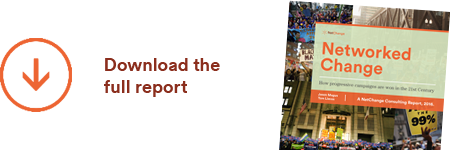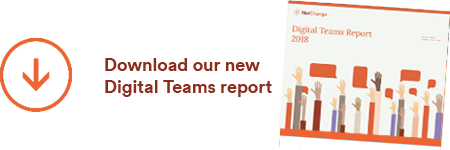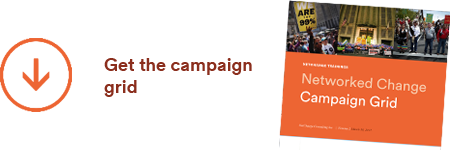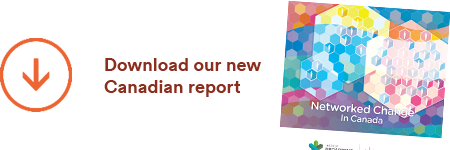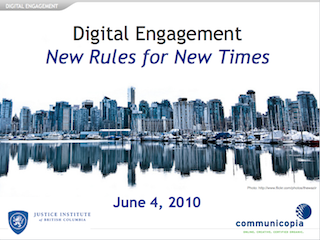 A few weeks ago I met Jennifer Lee, a bright, energetic woman with quite a business title: Online Channels Development Business Partner for the BC Safety Authority. She was one of a full house of participants attending an all-day digital engagement workshop hosted by the Justice Institute of British Columbia.
A few weeks ago I met Jennifer Lee, a bright, energetic woman with quite a business title: Online Channels Development Business Partner for the BC Safety Authority. She was one of a full house of participants attending an all-day digital engagement workshop hosted by the Justice Institute of British Columbia.
The session was led by my boss, Jason Mogus, who's presentation, "Digital Engagement – New Rules for New Times," seemed to be the perfect fuel for Jennifer's already burning fire for the digital space.
When I asked her at the break what she was getting so far out of the session, her eyes lit up and she said, "Finally someone is talking about how there is more to digital then just our website or Facebook page!"
And she's right, digital is more than just a channel, it represents an entire organization, and not just as a communications tool, but as a tool that supports many, if not all of an organization’s functions. Digital also points to an entirely new function most institutions aren’t so good at yet: listening and community engagement. Today, the organizations that truly succeed build digital into the core of what they do. But more often than not, institutions still don't have the vision, structures or processes in place that will lead them to major success.
Looking around, the group at the Justice Institute definitely seemed to resonate with that notion. I mean heck, these folks are the innovative thinkers in their respective public institutions (which included 3 police departments, Metro Vancouver, the province, the federal government, and numerous social service and advocacy agencies).
They see their own internal barriers to succeeding, and given a glimpse into what the future might look like, they really recognized the need to shift towards more collaborative, open, and responsive approaches internally. They just weren't sure how to make it happen.
Cut to Jason moving through an in-depth Power Point deck of slides, outlining his roadmap for how to be successful at building momentum for this very institutional change. Set up as basically an A-Z of what he’s learned in over a decade of doing digital projects for institutions, I noticed a lot of head-nodding in the room when he came to the slide that set out how to create compelling integrated digital visions that engage all departments and management in what is possible:
- Find internal champions as high up as possible who "get it": that the world has changed, audiences don’t respond the way they used to, and that we need to adapt to this new reality or risk getting sidelined
- Do a competitive analysis to get inspired by what is possible (and create a bit of healthy fear of being left behind)
- Map the interests and goals of key departments of the institution. Ask leaders how digital can support their goals. You’ll usually find a lot of people have good ideas they just haven’t been asked before!
- Align these with your organization's strategic plan – 9 times out of 10 most of what digital can deliver can be mapped directly onto where organizations realize they need to head anyway
- Communicate objectives in business or mission terms (not technical terms) and how digital is key to everyone getting what they want.
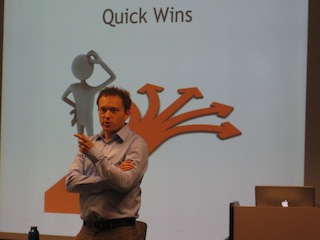
Once a vision is set, the really hard part is not letting all this new energy get stifled in the silo’d, separate, and often resistant-to-change cultures of most institutions. Jason spoke about the “3 historical structures” of digital teams (most institutions are in the 2nd one, with strong centralization of digital) and how today’s leading institutions manage digital well through a hybrid structure that distributes leadership and creates a more responsive structure.
Sounds easy, right? Strangely enough, after spending the day discussing the realities with Jason, participants seem to believe it might just be.
Speaking with Jennifer again Iater, she seemed calmer, though still excited about having put a number of the pieces together in a way she hadn’t before and collecting some valuable tools along the way. "It's all about having a holistic view on the world, no longer in silos. I mean, these days, digital touches all aspects of our lives!"
For the full A-Z, check out Jason’s presentation here.






